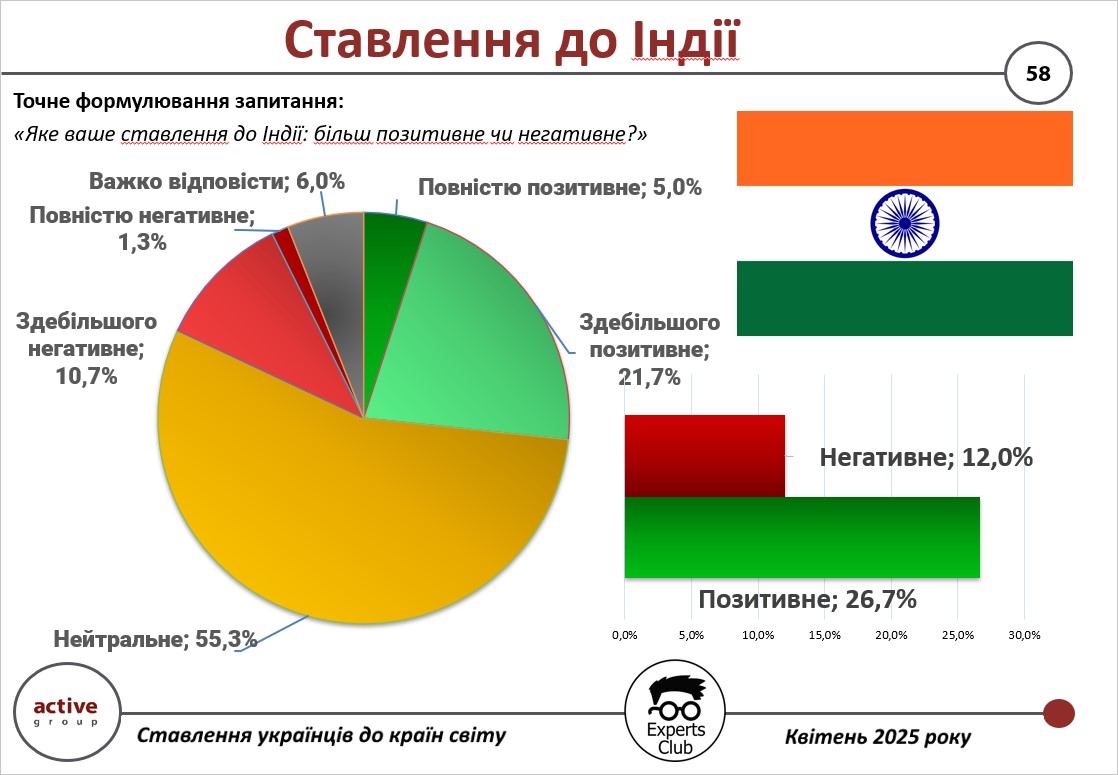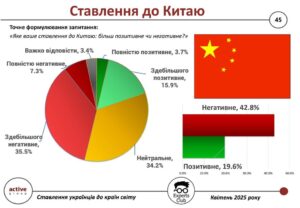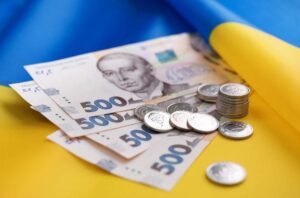
According to a survey conducted by Active Group and Experts Club, 26.7% of Ukrainians expressed a positive attitude toward India (21.7% — mostly positive, 5.0% — completely positive), while 12.0% expressed a negative attitude. The vast majority (55.3%) have a neutral attitude, which indicates that there is no established image of this country in the mass consciousness of Ukrainians.
“India is perceived as a country with a huge population, a dynamic economy, and a deep cultural heritage. At the same time, it is informationally distant from Ukrainian consumers, which creates a significant level of neutrality and low emotional coloring in its perception,” comments Maksim Urakin, PhD in Economics and founder of the Experts Club information and analytical center.

India remains a promising partner for the development of humanitarian and economic ties, but needs a more active information presence in Ukraine to form a clearer positive image.
The presentation of the study is available at the link.
ACTIVE GROUP, DIPLOMACY, EXPERTS CLUB, Pozniy, SOCIOLOGY, URAKIN

Ukrainian real estate marketplace DIM.RIA analyzed changes in the primary, secondary, and rental real estate sectors during April 2025. The study presents the dynamics of prices, supply, and demand compared to the previous month and April 2024.

Primary market
Supply
In April 2025, the share of open sales departments for new buildings remained unchanged compared to March — 77%. During the month, 16 new buildings (28 sections) were commissioned in Ukraine 6 in Lviv, 4 in Kyiv, 3 in Ivano-Frankivsk, and 1 each in Vinnytsia, Khmelnytskyi, and Rivne regions.

The largest number of completed new buildings among all objects was in Rivne (62%), Zaporizhzhia (56%), Odesa (54%), and Volyn (52%) regions.
Prices
The average price per square meter in US dollars increased the most in the Zhytomyr, Poltava, Odesa, and Dnipropetrovsk regions, with growth ranging from 3% to 5%. At the same time, Chernihiv and Kharkiv regions saw a significant drop in prices — 5% compared to March. Year-on-year, real estate prices fell the most in the frontline regions — Sumy, Zaporizhzhia, and Dnipropetrovsk. Kyiv remains the most expensive city — $1,369 per square meter.
Secondary market
Supply
The largest number of advertisements for the sale of secondary housing in April came from the Kirovohrad, Cherkasy, and Ternopil regions.

 Prices
Prices
According to the DIM.RIA analytical center, the average cost of one-room apartments in April increased in most regions. The largest increase was recorded in the Kherson region — +12%. The most expensive one-room apartments on the secondary market are in Kyiv. In the capital, owners set an average price of about $91,500. Looking at the capital in more detail, the most expensive district remains Pecherskyi, with an average price for a one-room apartment of almost $132,000, and the most affordable is Desnianskyi, where the average price is $45,000.

Demand
In April, user interest in secondary housing increased significantly across virtually the entire territory of Ukraine. The most active search for secondary real estate was in the Kirovohrad region.

The ratio of the number of purchase listings to the number of responses to them in April in Kyiv was 1:3, which is the smallest difference. In the Vinnytsia region, it was 1:18, in the Ternopil region — 1:15, in the Vinnytsia region — 1:14, and in the Mykolaiv region — 1:13.

Rental market
Supply
According to DIM.RIA analysts, the rental market was unstable in April: the largest number of new ads were published in the Kirovohrad (+84%), Cherkasy (+39%), and Odesa (+28%) regions; however, in the Poltava region, the number of offers in April decreased by 77% compared to March. In Kyiv, owners also published fewer new ads: 17% less than in March.

Prices
Kyiv remains the most expensive city for renting housing: the average cost in April was 17.5 thousand UAH, which is 2% less than in March. As always, the highest prices are listed by owners in the Pecherskyi district — 22,500 UAH, and the lowest in the Desnianskyi district — 10,500 UAH for a one-room apartment.

In all regions, this indicator fluctuated within a few percent during the month, with the exception of Poltava (10% increase), Kherson (22% decrease), and Kirovohrad (26% decrease) regions.

Demand
In April, users were actively looking for rental housing: according to data from the DIM.RIA analytical center, interest was observed in almost all regions of Ukraine. The ratio of rental listings to responses in April in Kyiv was 1:5, while in most regions these figures differed several times over.

The full analytical report and high-quality images are available at the link!

In April 2025, Active Group, in collaboration with the Experts Club think tank, conducted a survey of Ukrainians’ attitudes towards the People’s Republic of China. The results show a significant level of distrust, a small proportion of sympathy, and a high percentage of neutral attitudes.
According to the survey, 42.8% of Ukrainians have a negative attitude toward China. In particular, 35.5% have a mostly negative attitude, and 7.3% have a completely negative attitude. China is viewed positively by 19.6% of respondents, with 15.9% expressing a mostly positive attitude and 3.7% completely positive. A neutral position is held by 34.2% of those surveyed, while another 3.4% were unable to answer.
“China is perceived by Ukrainian society in an ambiguous way. On the one hand, it is an economic power and a potential partner, but on the other hand, Beijing’s vague position on Russia’s war against Ukraine is causing serious concern,” said Alexander Pozniy, co-founder of Active Group.
In turn, the candidate of economic sciences and founder of the Experts Club information and analytical center emphasized that the status of a major trading partner remains secondary compared to the political and moral position on the war.
“It is particularly interesting that even Ukraine’s economically important partners, such as China (its largest trading partner), receive low support ratings among Ukrainians. This indicates that Ukrainian society values moral support above real trade and does not recognize “neutrality” if it is not accompanied by humanitarian gestures,” added Maxim Urakin.
Thus, Ukrainians’ attitude toward China remains rather negative: criticism and distrust prevail, although one in five still has a positive opinion, and one-third remain undecided.
The presentation of the study is available at the link.
ACTIVE GROUP, DIPLOMACY, EXPERTS CLUB, Pozniy, SOCIOLOGY, URAKIN

The full integration of Ukrainian business into the European market remains a key strategic goal of the Ukrainian Chamber of Commerce and Industry for 2024–2025. This was announced by the head of the CCI, Gennady Chizhikov, in an exclusive interview with the Interfax-Ukraine news agency.
“We are supporting the processes of certification, adaptation of logistics, labeling, and marketing materials for companies entering the EU markets. There are already specific cases where, thanks to this work, Ukrainian goods are being sold in Germany and Belgium,” Chizhikov said.
For more details, see the interview at https://interfax.com.ua/news/interview/1069297.html

Serbia is one of the few European countries towards which Ukrainians demonstrate a predominantly reserved or negative attitude. These results were obtained during a public opinion poll conducted by the sociological company Active Group in April 2025 in conjunction with the analytical center Experts Club.
According to the survey, 19.3% of Ukrainians have a negative attitude toward Serbia (15.3% — mostly negative, 3.9% — completely negative). A positive opinion was expressed by 16.4% (12.9% — mostly positive, 3.6% — completely positive). However, the largest share — 59.8% — chose a neutral position, and another 4.5% were unable to answer.

“Unlike attitudes toward Hungary or Slovakia, negative and positive attitudes toward Serbia are almost equal, with a neutral position prevailing at 60%. Serbia is balancing between the EU and Russia and China for a comfortable political and economic existence. Despite its geographical proximity and cultural affinity, Serbia’s image in Ukraine needs to be rethought and reoriented to improve bilateral relations,” emphasized Maksim Urakin, founder of Experts Club.
The presentation of the study is available at the link.
ACTIVE GROUP, DIPLOMACY, EXPERTS CLUB, Pozniy, SOCIOLOGY, URAKIN

Ukraine’s state budget revenues in April 2025 amounted to UAH 336.2 billion, including UAH 274.7 billion from the general fund, which is 65.2% and 77.7% more than in April 2024, according to preliminary data from the State Treasury published on the Ministry of Finance website on Monday.
The agency specified that value added tax (VAT) on goods produced in Ukraine in April this year brought in UAH 27.6 billion compared to UAH 23.2 billion last year, while VAT refunds increased to UAH 13.0 billion from UAH 12.0 billion.
Import VAT added another UAH 40.6 billion to the budget (UAH 39.3 billion in February 2024), corporate income tax – UAH 5.6 billion (UAH 3.2 billion), personal income tax and military tax – UAH 29.7 billion (UAH 16.8 billion), rent payments for subsoil use amounted to UAH 3.2 billion (UAH 5.3 billion). Excise tax brought in another UAH 24.2 billion (UAH 17.3 billion), import and export duties amounted to UAH 4 billion (UAH 4 billion).
Revenues from the Unified Social Tax to the Pension Fund and social insurance funds in April this year increased to UAH 54.9 billion from UAH 44.4 billion last year, the Ministry of Finance added.
It is noted that the State Tax Service exceeded the monthly revenue target by 14.3%, or UAH 10.4 billion, while the State Customs Service fell short by 8.0%, or UAH 4.6 billion.
In addition, in April 2025, the general fund of the state budget received UAH 63.9 billion from the National Bank of Ukraine, which transferred part of its profits to the state budget, and UAH 69.2 billion in international aid (grants), while in April last year these revenues amounted to UAH 38.6 billion and UAH 2.7 billion, respectively.
In total, over the first four months of this year, Ukraine’s state budget revenues amounted to UAH 1 trillion 262.4 billion, including UAH 856.3 billion in the general fund, which is 49.3% and 37.3% more than in 2024, respectively. Among other things, international assistance in the form of grants increased more than fourfold, from UAH 40.3 billion to UAH 167 billion.
The Ministry of Finance also indicates that actual government borrowing to the general fund of the state budget in January-April 2025 amounted to UAH 604.0 billion, or 104.0% of the planned amount for this period, while in the same period last year, it amounted to UAH 564.1 billion, or 96.5% of the plan.
At the same time, the placement of government bonds increased to UAH 154.0 billion from UAH 143.3 billion, while in foreign currency it even decreased to $642.0 million and EUR188.8 million from $749.5 million and EUR552.1 million last year. In addition, sales of military government bonds fell to UAH 77.3 billion from UAH 111.4 billion.
External sources provided UAH 450.0 billion (or about $10.8 billion) in the first four months of this year, compared with UAH 420.8 billion ($10 billion) in the first four months of last year.
Payments on state debt repayment for January-April 2025 increased to UAH 225.2 billion compared to UAH 146.7 billion for January-April 2024, and service payments increased to UAH 92.5 billion from UAH 64.5 billion.
As reported, the 2025 state budget was approved with revenues of UAH 2 trillion 327.1 billion, including the general fund of UAH 2 trillion 133.3 billion (excluding grants and international aid), and expenditures of UAH 3 trillion 929.1 billion, including the general fund – 3 trillion 591.6 billion UAH.
According to the Ministry of Finance, in 2024, the state budget received 3 trillion 120.5 billion UAH in revenues, which is 448 billion UAH, or 16.8%, more than the 2023 state budget. The general fund’s revenue grew by 513.9 billion UAH, or 30.9%, to 2 trillion 177 billion UAH, including international financial assistance in the form of grants amounting to 453.6 billion UAH compared to 433.9 billion UAH in 2023.
State budget expenditures in 2024 increased by UAH 464.5 billion, or 11.6%, compared to 2023, to UAH 4 trillion 479.3 billion, including the general fund increased by 15%, or UAH 454.5 billion, to UAH 3 trillion 488.8 billion.